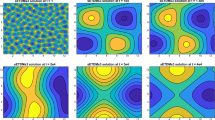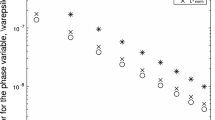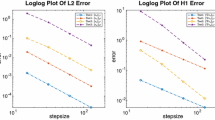Abstract
In this paper we are concerned with the stability and convergence analysis of the second order backward differentiation formula (BDF2) scheme with variable time steps for the no-slope-selection (NSS) equation of the epitaxial thin film growth model, with Fourier pseudo-spectral method in physical domain. Under the adjoint time-step ratio condition \(r_k := \tau _k /\tau _{k-1} < 4.864\), the variable-step BDF2 scheme is uniquely solvable and stable in \(L^2\)-norm, also we establish a rigorous error estimate with a novel discrete orthogonal convolution kernels involved in the analysis. Finally, the adaptive time step strategy is used to accelerate the calculation of the steady-state solution, and the theoretical results are verified by numerical examples. In addition, the long time simulation results have indicated a logarithm law for the energy decay, as well as the power laws for growth of the surface roughness and the mound width.





Similar content being viewed by others
References
J. Becker. A second order backward difference method with variable steps for a parabolic problem. BIT, 38(4), 644–662, 1998
C. Chen and X. Yang. A second-order time accurate and fully-decoupled numerical scheme of the Darcy-Newtonian-Nematic model for two-phase complex fluids confined in the Hele-Shaw cell. J. Comput. Phys., 456:111026, 2022
W. Chen, S. Conde, C. Wang, X. Wang, and S.M. Wise. A linear energy stable scheme for a thin film model without slope selection. J. Sci. Comput., 52(3):546–562, 2012
W. Chen, C. Wang, X. Wang, and S.M. Wise. A linear iteration algorithm for a second-order energy stable scheme for a thin film model without slope selection. J. Sci. Comput., 59(3):574–601, 2014
W. Chen, X. Wang, Y. Yan, and Z. Zhang. A second order BDF numerical scheme with variable steps for the Cahn-Hilliard equation. SIAM J. Numer. Anal., 57(1):495–525, 2019
C. Chen, X. Li, J. Zhang, and X. Yang. Efficient linear, decoupled, and unconditionally stable scheme for a ternary Cahn-Hilliard type Nakazawa-Ohta phase-field model for tri-block copolymers. Appl. Math. Comput., 388:125463, 2021
Cooley JW, Tukey JW (1965) An algorithm for the machine calculation of complex fourier series. Math. Comp. 19:297–301
G. Ehrlich and F.G. Hudda. Atomic view of surface self-diffusion: tungsten on tungsten. J. Chem. Phys., 44(3):1039–1049, 1966
Eyre DJ (1998) Unconditionally gradient stable time marching the cahn-hilliard equation. MRS Online Proc Libr OPL 1998:529
L. Golubovic. Interfacial coarsening dynamics in epitaxial growth with slope selection. Phys. Rev. E, 61(6):6190, 2000
H. Gomez and T. Hughes. Provably unconditionally stable, second-order time-accurate, mixed variational methods for phase-field models. J. Comput. Phys., 230(13):5310–5327, 2011
Gottlieb D, Orszag SA (1977) Numerical analysis of spectral methods, theory and applications. SIAM, Philadelphia, PA
R.D. Grigorieff. Stability of multistep-methods on variable grids. Numer. Math., 42(3):359–377, 1983
Hesthaven JS, Gottlieb S, Gottlieb D (2007) Spectral methods for time-dependent problems, vol 21. Cambridge University Press, Cambridge, UK
Ju L, Li X, Qiao Z, Zhang H (2018) Energy stability and error estimates of exponential time differencing schemes for the epitaxial growth model without slope selection. Math. Comp. 87(312):1859–1885
Y. Kang, H.-L Liao, and J. Wang. An energy stable linear BDF2 scheme with variable time-steps for the molecular beam epitaxial model without slope selection. Commun. Nonlinear Sci. Numer. Simul., 118:107047, 2023
Kohn RV, Yan X (2003) Upper bound on the coarsening rate for an epitaxial growth model. Comm. Pure Appl. Math. 56(11):1549–1564
M.-N. LeRoux. Variable step size multistep methods for parabolic problems. SIAM J. Numer. Anal., 19(4):725–741, 1982
B. Li. High-order surface relaxation versus the Ehrlich-Schwoebel effect. Nonlinearity, 19(11):2581, 2006
B. Li and J. Liu. Thin film epitaxy with or without slope selection. Eur. J. Appl. Math., 14(6):713–743, 2003
Li B, Liu J (2004) Epitaxial growth without slope selection: energetics, coarsening, and dynamic scaling. J. Nonlinear Sci. 14(5):429–451
W. Li, W. Chen, C. Wang, Y. Yan, and R. He. A second order energy stable linear scheme for a thin film model without slope selection. J. Sci. Comput., 76(3):1905–1937, 2018
Liao H-L, Zhang Z (2021) Analysis of adaptive BDF2 scheme for diffusion equations. Math. Comp. 90(329):1207–1226
Liao H-L, Ji B, Wang L, Zhang Z (2021a) Mesh-robustness of the variable steps BDF2 method for the Cahn-Hilliard model. arXiv:2102.03731
Liao H-L, Song X, Tang T, Zhou T (2021b) Analysis of the second order BDF scheme with variable steps for the molecular beam epitaxial model without slope selection. Sci China Math 64(5):887–902
H.-L Liao, B. Ji, and L. Zhang. An adaptive BDF2 implicit time-stepping method for the phase field crystal model. IMA J. Numer. Anal., 42(1):649–679, 2022
Meng X, Qiao Z, Wang C, Zhang Z (2020) Artificial regularization parameter analysis for the no-slope-selection epitaxial thin film model. CSIAM Trans. Appl. Math 1:441–462
Q. Pan, T. Rabczuk, and X. Yang. Subdivision-based isogeometric analysis for second order partial differential equations on surfaces. Comput. Mech., 68(5):1205–1221, 2021
Z. Qiao, Z. Zhang, and T. Tang. An adaptive time-stepping strategy for the molecular beam epitaxy models. SIAM J. Sci. Comput., 33(3):1395–1414, 2011
J. Shen. Long time stability and convergence for fully discrete nonlinear galerkin methods. Appl. Anal., 38:201–229, 1990
J. Shen and X. Yang. The IEQ and SAV approaches and their extensions for a class of highly nonlinear gradient flow systems. Contemp. Math., 754:217–245, 2020
Shen J, Tang T, Wang L (2011) Spectral methods: Algorithms, analysis and applications, vol 41. Springer-Verlag, Berlin Heidelberg
J. Shen, C. Wang, X. Wang, and S.M. Wise. Second-order convex splitting schemes for gradient flows with Ehrlich-Schwoebel type energy: application to thin film epitaxy. SIAM J. Numer. Anal., 50(1):105–125, 2012
X. Yang. A novel fully decoupled scheme with second-order time accuracy and unconditional energy stability for the Navier-Stokes equations coupled with mass-conserved Allen-Cahn phase-field model of two-phase incompressible flow. Int. J. Numer. Meth. Eng., 122(5):1283–1306, 2021
X. Yang and G. Zhang. Convergence analysis for the invariant energy quadratization (IEQ) schemes for solving the Cahn-Hilliard and Allen-Cahn equations with general nonlinear potential. J. Sci. Comput., 82:1–28, 2020
Acknowledgements
Z.R. Zhang is supported by National Natural Science Foundation of China (NSFC) 11871105, 12231003.
Author information
Authors and Affiliations
Corresponding author
Additional information
Publisher's Note
Springer Nature remains neutral with regard to jurisdictional claims in published maps and institutional affiliations.
Rights and permissions
Springer Nature or its licensor (e.g. a society or other partner) holds exclusive rights to this article under a publishing agreement with the author(s) or other rightsholder(s); author self-archiving of the accepted manuscript version of this article is solely governed by the terms of such publishing agreement and applicable law.
About this article
Cite this article
Meng, X., Zhang, Z. An adaptive BDF2 implicit time-stepping method for the no-slope-selection epitaxial thin film model. Comp. Appl. Math. 42, 124 (2023). https://doi.org/10.1007/s40314-023-02250-9
Received:
Revised:
Accepted:
Published:
DOI: https://doi.org/10.1007/s40314-023-02250-9
Keywords
- Epitaxial thin film growth
- Variable-step BDF2 scheme
- Discrete orthogonal convolution kernels
- Convergence analysis
- Fourier pseudo-spectral method




